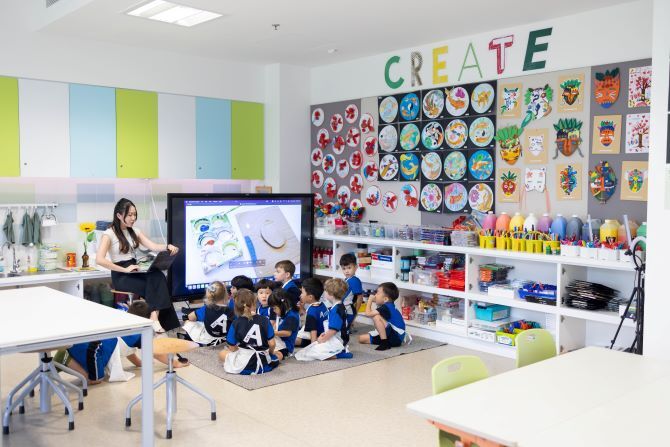The state of America’s education system has been a topic of concern and debate for many years. Recent data shows that math and reading scores for 13-year-olds have hit their lowest levels in decades. Despite significant federal spending on K-12 schooling, students are performing worse than they were a decade ago, and lower-performing students are struggling even more than they were 35 years ago. This alarming trend highlights the need for urgent action to address the shortcomings of the education system. America’s Education System: A Deep Dive Analysis.
The Impact of COVID-19 on Education

The COVID-19 pandemic has undoubtedly played a role in exacerbating the challenges faced by the education system. The long shadow cast by the pandemic has disrupted traditional learning environments and created significant obstacles for both students and educators. Despite nearly $200 billion in emergency federal spending on K-12 schooling, the expected improvements in student performance have not materialized. It is clear that simply pouring money into the system is not enough to drive meaningful change.
The Pervasive Weariness and Lack of Solutions
The reactions to the recent National Assessment of Educational Progress (NAEP) results have been predictable. Commentaries on the data have used words such as “alarming,” “terrifying,” and “tragic” to describe the situation. However, while the problems are evident, viable solutions seem to be lacking. Experts agree that Herculean efforts are needed to address the shortfalls, but there is little consensus on what those efforts should entail. This lack of clarity and direction is hindering progress in the education system.
The Great Divide in Education Policy

The education policy community is divided on the root causes of the education system’s failures. On one side, defenders of public education blame chronic underfunding of schools and teacher salaries, as well as an overreliance on standardized testing. On the other side, conservative critics point to the lack of school choice, poor teacher preparation programs, and the perceived intrusion of woke ideology into classrooms. Both sides have valid points, but addressing only one aspect of the problem is unlikely to lead to significant improvements.
Symptoms of a Deeper Issue
While underfunding and inadequate teacher preparation contribute to the challenges faced by the education system, they are merely symptoms of a more profound issue. Factors beyond the schoolhouse door, such as the legacy of race-based redlining and the underfunding of healthcare and social support, have a significant impact on student outcomes. These systemic issues must be addressed alongside internal changes to the education system.
Erosion of the Instructional Core
One of the fundamental causes of poor outcomes in the education system is the erosion of the instructional core. Pre-K education often lacks consistency and fails to adequately prepare students for kindergarten. By the time students are assessed at the age of 8, it is often too late to provide effective interventions, resulting in persistent achievement gaps. Furthermore, the lack of alignment between curricula, tests, and teacher education programs creates a fragmented system that hinders effective teaching and learning.
Disconnected Testing and Student Incentives
Unlike many advanced industrialized nations, the United States disconnects testing from student incentives. While state tests are used to evaluate schools, they often hold little relevance for students themselves. The absence of a direct link between high school exit exams and college admissions further undermines the importance of test results. Additionally, grade inflation is prevalent, with inflated grades masking true levels of student achievement.
The Preferential Ranking of Subjects
The education system’s focus on reading, math, and science often leaves other subjects, such as the arts and technical education, neglected. This narrow prioritization limits students’ opportunities and fails to recognize the diverse talents and interests of individuals. While some countries, like Switzerland, provide robust pathways from school to employment, the United States often directs students into dead-end experiences that do not equip them with the necessary skills for success in the job market.
The Decline of Academic Achievement
Academic achievement itself seems to be losing its importance in the education system. Critical thinking, metacognition, and “21st-century skills” have gained prominence, while mastery of content takes a backseat. However, it is essential to recognize that students cannot think critically without a solid foundation of knowledge. Competence in mathematics and other core subjects remains crucial for overall academic success.
The Impact of Technology in Education
The American education system has invested heavily in educational technology, with an estimated annual spending of at least $30 billion. However, the return on this investment has been underwhelming. Despite the promises of technology, including artificial intelligence, as a solution to educational challenges, it has not delivered the desired outcomes. The unique sense of achievement that comes from mastering rigorous skills and engaging in deep learning experiences is being overshadowed by the reliance on technology.
The Role of Social and Emotional Learning
In response to the increasing challenges faced by students, many American school systems have emphasized social and emotional learning (SEL). While providing effective support for students’ mental health is crucial, the notion that SEL represents a new science is questionable. Encouraging students and fostering a growth mindset have been known strategies for centuries. The focus on SEL should not overshadow the importance of academic rigor and content mastery.
The Urgent Need for Change
The shortcomings of America’s education system cannot be ignored any longer. The education community, policymakers, and society at large must come together to address the systemic issues that hinder student success. This includes tackling issues of underfunding, improving teacher preparation programs, ensuring equitable access to quality education, and reevaluating the priorities and structure of the curriculum. Only through comprehensive and holistic reforms can we create an education system that truly prepares students for the challenges of the future.

In conclusion, America’s education system is facing significant challenges that require immediate attention. The impact of the COVID-19 pandemic, coupled with systemic issues such as chronic underfunding and inadequate preparation, has led to declining student performance. To reverse this trend, a multifaceted approach is needed, addressing issues both within and outside the school system. By prioritizing academic rigor, supporting students’ social and emotional well-being, and investing in comprehensive reforms, we can ensure that all students have access to a quality education that prepares them for success in the modern world.
